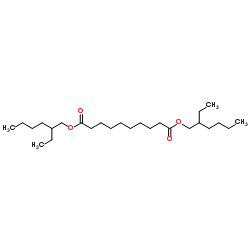diisooctyl sebacate

diisooctyl sebacate structure
|
Common Name | diisooctyl sebacate | ||
|---|---|---|---|---|
| CAS Number | 122-62-3 | Molecular Weight | 426.673 | |
| Density | 0.9±0.1 g/cm3 | Boiling Point | 435.5±0.0 °C at 760 mmHg | |
| Molecular Formula | C26H50O4 | Melting Point | -55 °C | |
| MSDS | Chinese USA | Flash Point | 189.7±18.2 °C | |
|
Fast synthesis of platinum nanopetals and nanospheres for highly-sensitive non-enzymatic detection of glucose and selective sensing of ions.
Sci. Rep. 5 , 15277, (2015) Novel methods to obtain Pt nanostructured electrodes have raised particular interest due to their high performance in electrochemistry. Several nanostructuration methods proposed in the literature use costly and bulky equipment or are time-consuming due to th... |
|
|
Textile-based sampling for potentiometric determination of ions.
Anal. Chim. Acta 877 , 71-9, (2015) Potentiometric sensing utilizing textile-based micro-volume sampling was applied and evaluated for the determination of clinically (Na(+), K(+), Cl(-)) and environmentally (Cd(2+), Pb(2+) and pH) relevant analytes. In this technological design, calibration so... |
|
|
Quantitative determination of fucoidan using polyion-sensitive membrane electrodes.
Anal. Chim. Acta 877 , 1-8, (2015) The use of polyanion and polycation-sensitive membrane electrodes to detect five different preparations of fucoidan is described. Unlike linear polyanionic molecules previously measured with polymer membrane-based electrochemical sensors, fucoidans from marin... |
|
|
Enhancing biocompatibility of some cation selective electrodes using heparin modified bacterial cellulose.
Carbohydr. Polym. 134 , 687-94, (2015) Bacterial cellulose (BC) and heparin-modified bacterial cellulose (HBC) were utilized to enhance the biocompatibility of highly thrombogenic PVC-based potassium and calcium membrane electrodes. Three types of membrane electrodes were prepared: (1) conventiona... |
|
|
Variation in penetration of submicrometric particles through electrostatic filtering facepieces during exposure to paraffin oil aerosol.
J. Occup. Environ. Hyg. 9(9) , 556-61, (2012) Several studies show the increase of penetration through electrostatic filters during exposure to an aerosol flow, because of particle deposition on filter fibers. We studied the effect of increasing loads of paraffin oil aerosol on the penetration of selecte... |
|
|
Sensitive and selective detection of trace copper in standard alloys, food and biological samples using a bulk optode based on N,N'-(4,4'-ethylene biphenyl) bis(3-methoxy salicylidine imine) as neutral carrier.
Spectrochim. Acta. A. Mol. Biomol. Spectrosc. 107 , 280-8, (2013) In this paper, an optical sensing film has been proposed for sensitive determination of copper (ІІ) ion in aqueous solutions. The copper sensing membrane was prepared by incorporating N,N'-(4,4'-ethylene biphenyl) bis(3-methoxy salicylidine imine) as ionophor... |
|
|
Experimental evaluation of oil mists using a semivolatile aerosol dichotomous sampler.
J. Occup. Environ. Hyg. 7(4) , 203-15, (2010) The sampling performance of the semivolatile aerosol dichotomous sampler (SADS) was tested and compared with existing vapor and particle sampling methods: filtration, electrostatic precipitation, and vapor adsorption. Seven different test fluids were used to ... |
|
|
Intersubject variability in particle deposition does not explain variability in responsiveness to methacholine.
Am. Rev. Respir. Dis. 144(3 Pt 1) , 649-54, (1991) How variable is the deposition of inhaled methacholine (MCH) in the respiratory tract during a challenge test? Does this variability contribute to the variability of airway responsiveness? To examine these questions we estimated the deposition of polydisperse... |
|
|
Spectrophotometric determination of various polyanions with polymeric film optodes using microtiter plate reader.
Anal. Chim. Acta 699(1) , 107-12, (2011) Polycation-sensitive membrane optodes based on the chromoionophore 2',7'-dichlorofluorescein octadecylester (DCFOE) have previously been developed and used for determination of heparin via a titrimetric method. In this study, it is shown that some other impor... |
|
|
Interindividual variability in nasal filtration as a function of nasal cavity geometry.
J. Aerosol Med. Pulm. Drug Deliv. 22(2) , 139-55, (2009) Interindividual variability in nasal filtration is significant due to interindividual differences in nasal anatomy and breathing rate. Two important consequences arise from this variation among humans. First, devices for nasal drug delivery may furnish quite ... |